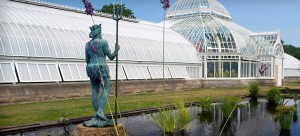 Last week, Dole Food Company, participated in the second annual Forum on Sustainability and Happiness in Costa Rica. This year, former U.S. President Bill Clinton provided the closing keynote, delivering a message on environmental sustainability. Dole’s Sylvain Cuperlier, Vice President of Corporate Responsibility and Sustainability introduced the Forum’s roundtable on sustainable agriculture. In this introduction, Cuperlier discussed the potential issues related to pesticide use, the need for a more pro-active response to climate change and the requirement to focus further on water use and soil conservation. He also highlighted some challenges specific to agriculture, like how the increasing market pressure on prices can be a constraint when it comes to extending sustainable production practices.
Last week, Dole Food Company, participated in the second annual Forum on Sustainability and Happiness in Costa Rica. This year, former U.S. President Bill Clinton provided the closing keynote, delivering a message on environmental sustainability. Dole’s Sylvain Cuperlier, Vice President of Corporate Responsibility and Sustainability introduced the Forum’s roundtable on sustainable agriculture. In this introduction, Cuperlier discussed the potential issues related to pesticide use, the need for a more pro-active response to climate change and the requirement to focus further on water use and soil conservation. He also highlighted some challenges specific to agriculture, like how the increasing market pressure on prices can be a constraint when it comes to extending sustainable production practices.
Cuperlier pinpointed some opportunities for collaboration, as well. Participation in multi-stakeholder initiatives aimed at exchanging best sustainable practices, through the Costa Rican platform and the World Banana Forum, was a central focus.”Our participation for the second time in the Forum was a great opportunity for Dole to reaffirm our leadership role in sustainability, while highlighting, with full transparency, the challenges and opportunities our industry can encounter along the way,” said Cuperlier. “These events are so valuable because they bring together some many stakeholders, new and established, to discuss issues that span such a wide variety of companies, industries and regions.”
Vega will further discuss Dole’s sustainability initiatives in the working group on Food Security and Sustainable Agriculture at Business for the Environment (B4E) Global Summit 2012, which will take place May 21-22 in Berlin, Germany. B4E is the leading international platform for dialogue and partnership solutions for the environment. The recommendations from the working groups organized in Berlin will be presented as official business input for decision-makers at Rio+20, the United Nations conference on Sustainable Development, which will take place in Rio de Janeiro, Brazil, at the end of June.







